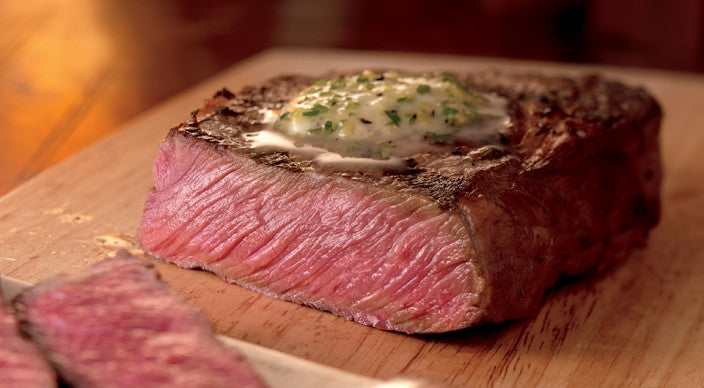
It seems the meat-eating world tends to get obsessed with marbling when it comes to judging a good steak. Marbling is, of course, a key factor when it comes to enjoying tenderness and flavour, but it can also serve as an obstacle when we think of quality beef ONLY in terms of marbling as it tends to mask the other important factors when it comes to understanding what 'good' steak is, like how the animal was raised and what it was fed.
These days, most calves are born on ranches, suckled by their mothers, and then sent out to pasture. When they reach six months, they're sent to a feedlot where they're "finished" on grain, usually corn. Grain isn't a cow's natural diet, but it's the feed of choice for two reasons: it makes cattle gain weight quickly, and it results in well-marbled beef.
When Sasha, our founder, first set out on her mission to bring quality meat to Singapore, she saw the lack of transparency with food provenance a huge warning sign and one that she wanted to rectify. She wanted to bring the same quality of meat that we enjoy in the UK, Australia and other countries where quality farming is part of the fabric of everyday life to all of the families in Singapore who would have otherwise been settling for a lesser-quality product.
This involved a lot of groundwork and research, including many trips to cattle farms all over Australia to inspect and scrutinise the entire process of farming from farm to plate.
But what is it that Sasha was looking for and what is it that Sasha's Fine Foods now offers to our customers other than 'good marbling'?
Here are a few of the factors that Sasha had to consider:
Breed: The traditional British breeds of cattle are the most popular due to their flavour, reliability of natural marbling and tenderness. Such breeds are the most highly demanded in the world for these reasons, which is why Sasha made sure she found a supplier who looked after stock that is purely British and not mixed with a lesser-quality breed that might be cheaper to raise. She was right to do so as intensive grain-feeding techniques have become so effective that even dairy cattle (such as Holsteins) can achieve a grade of Prime. Does a Prime steak from a dairy cow taste as good as a Prime steak from an Angus cow? The answer is decidedly 'No', so making sure you know what you're getting at the start of the chain is of the utmost importance.
Feed: Just as soil affects the quality of wine, a cow's diet can change the quality of its flesh. Cows are ruminants, which means that their natural diet consists of grasses and herbs found in their natural environment. Feeding a cow corn, as most cattle farms do at least for a portion of the cow's life, makes the cow gain weight faster and gives it good marbling, but it is also not a cow's natural diet. This leads to a higher fat content and less naturally developing nutrients in the meat. It's sort of like humans only eating processed food, as opposed to a balanced omnivorous diet of fruit, veg and meat. The very best option is to allow the cows to graze in the most pristine environment possible. Even air quality and rain quality should be considered when raising cattle - the cleaner the environment, the more pure the flavour of the meat.

Hormones: It is a sad fact that almost all feedlot cows are injected with growth hormones to help them gain muscle mass; critics charge that doing so merely causes cows to retain water and produces bland meat. This is mild criticism as far as we're concerned; there is no situation where we think the use of hormones should ever be given to animals fit for consumption. All of our beef is totally hormone and antibiotic free - it is natural beef, just as Mother Nature intended.
Quality of Life: A recent and not uncommon taste test of steak, from some of the best suppliers in the world, singled out one clear winner and a near second place. The meat was judged on flavour, juiciness, and tenderness and then assigned an overall preference. Each steak was sprinkled with kosher salt, then sent to a very hot gas-fired grill, flipped once, and, when just verging on medium-rare, was removed and rested under foil for five minutes.
The Verdict: "Marbling, schmarbling. The steak [from cows that had never ingested anything other than mother's milk and pasture, which is as Mother Nature intended] tasted the best—and was also the cheapest. This steak also had the least marbling out of any of the steaks! That said, the steak with the most marbling came in a not–too-distant second. Do the two share anything in common? Interestingly, neither was finished on straight corn or treated with hormones and both steaks hailed from ranches that pride themselves on their humane treatment of bovines."
Read more about this taste test here.
- Mark Schatzker is the author of The Dorito Effect: The Surprising New Truth About Food and Flavor.
So there it is, in a blind unbiased taste test with some serious competition, animals that had the best quality of life also tasted the best.
This is what we already knew at Sasha's Fine Foods, and certainly what Sasha thinks about when she makes sure that every step of the farming process from farm to plate adheres to our strict standards.
But don't listen to us anymore ... the proof is in the beef!
Try our wholesome, natural grass-fed beef, tender and rich in flavour.

